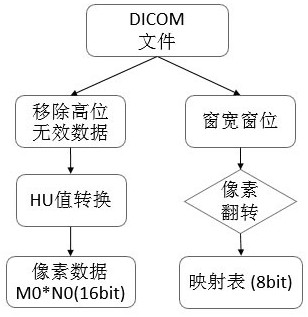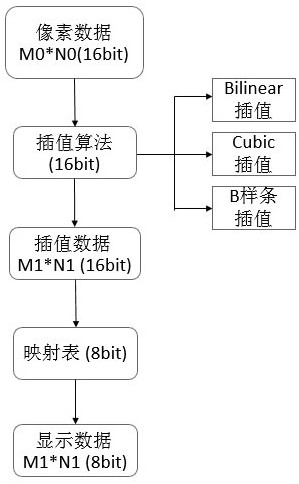A method for reducing the loss of magnification precision for medical images
A medical image and precision technology, applied in the field of medical image processing algorithms, can solve problems such as loss of precision, affecting real-time interaction, and excessive calculation, achieving pixel contrast guarantee, guaranteeing real-time interaction, and improving interpolation accuracy.
- Summary
- Abstract
- Description
- Claims
- Application Information
AI Technical Summary
Problems solved by technology
Method used
Image
Examples
Embodiment 1
[0046] Such as image 3 As shown, a method for reducing the loss of magnification accuracy for medical images provided in this embodiment includes the following steps:
[0047] 1) Read the DICOM file into the memory, and analyze the file according to the standard; first, skip the 128-byte DICOM header information, obtain the actual data encoding information through the metadata field, extract and store the actual data segment tag value, and use double-byte Save the Tag(7fe0, 0010) field value, which is the original pixel data PixelData0(M0*N0);
[0048] 2) According to the field Tag (0028, 0101), the actual number of pixels stored in the pixel is obtained, and the pixel data of PixelData0 is intercepted at a high level through the template method;
[0049] 3) Due to the different calibrations selected by the manufacturer, it is necessary to convert the optical density value of the above PixelData0 data to obtain the real image pixel value, and define the transformed pixel data ...
PUM
 Login to View More
Login to View More Abstract
Description
Claims
Application Information
 Login to View More
Login to View More - R&D
- Intellectual Property
- Life Sciences
- Materials
- Tech Scout
- Unparalleled Data Quality
- Higher Quality Content
- 60% Fewer Hallucinations
Browse by: Latest US Patents, China's latest patents, Technical Efficacy Thesaurus, Application Domain, Technology Topic, Popular Technical Reports.
© 2025 PatSnap. All rights reserved.Legal|Privacy policy|Modern Slavery Act Transparency Statement|Sitemap|About US| Contact US: help@patsnap.com



